Verbs are one of the nine parts of speech and here they are enlisted in alphabetical order.

It’s worth noting that verbs are a core part of speech. A sentence cannot be written without a verb.
Definition
Verbs represent physical and mental actions or states of being.
Verbs of Physical Actions
- dancing
- jumping
- washing
For example, Huma is dancing, her brother is jumping, and mom is washing dishes. These are physical actions.
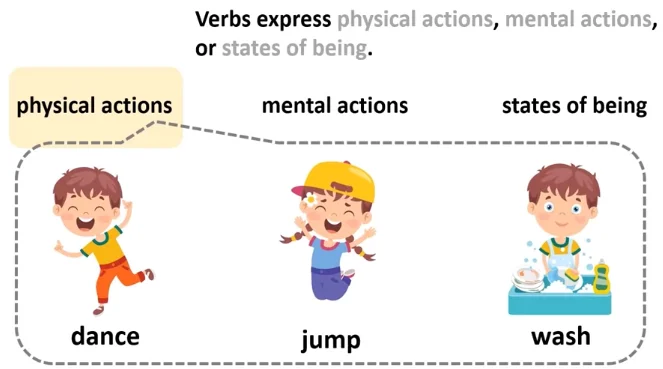
Verbs of Mental Actions
- thinking
- guessing
- considering
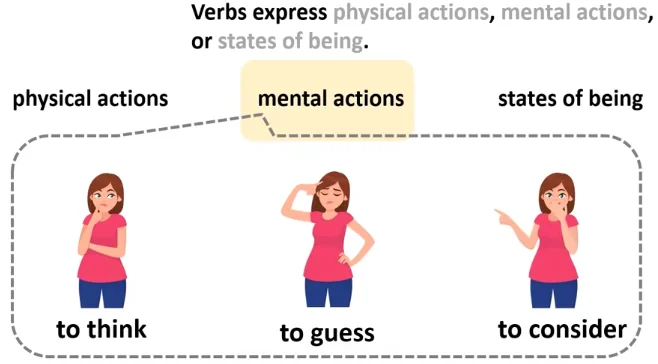
For example, My friend thinks that he cannot guess about the paper without considering my help. So, these are mental actions, here the activity is going on inside the head my friend.
Verbs of States of Being
- be
- is
- am
- are
- was
- were
- will be
- shall be
- being
- been
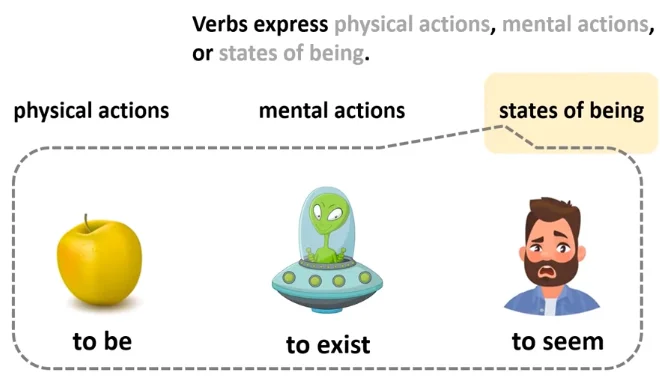
The verbs “to be,” “to exist,” and “to appear.” All of these are states of being. There is an apple, or there was an apple, or there will be an apple, for example. It just informs us of our current condition of being. What if there were two apples? Then there are apples, or there will be apples. It’s merely letting us know that they’re conveying a state of being using verbs. Stative verbs are quite abundant in these states of being verbs.
Examples of Verbs
- John washes his plates and dishes after breakfast.
- When he was a boy john washed his plates and dishes after breakfast.
- When he’s older john will wash his plates and dishes after breakfast.
- John is washing his plates and dishes after breakfast.
- He was washing his plates and dishes when I first met him.
- Johnn had washed his plates and dishes before I arrived.
All of the highlighted words are verbs that mean “to wash,” yet they are all distinct. There are six distinct versions available. However, there might be as many as twelve separate variations. There are various factors to consider every time you employ a verb, such as who or what is doing the action or being.
In the end, it’s all about understanding when the action occurred and whether it’s still happening or completed. The subject of the verb is the person who performs or receives the action.
Features of Verbs

Johnny is washing plates and dishes. The underlined word is a verb. So, let’s look at who or what =that is John, the subject of the verb.
Tense of Verb
Let’s have a look at when. So, it’s now happening, and John is doing the dishes. That’s why we had to use it; we could have used was or will be, but john is doing it right now, therefore we had to use it when the tense of a verb is mentioned.
Aspect of Verbs
Let’s have a look at the following one: is the action ongoing or completed? It’s ongoing in this case, which is why we utilized washing. This is the meaning of the verb’s aspect.
Subject of Verb
That one is the subject, which we now know is the action’s doer or recipient. And the answer to that question defines the form of our sentences, which we refer to as voice.
Voice of Verbs
Either the active or passive voice is used in the sentence. It’s either the subject performing the verb (which is active) or something being done to the subject (which is passive). And the form of the phrase is determined by the response to that question.
We now know that our verb’s appearance is determined by at least four factors. Let’s take a closer look at each one, starting with the theme. Every verb’s subject will fall into one of these groups.
Every subject will fall into one of these categories, whether it’s I, you, he, she, we, you, they, or any plural nouns like puppies, males, or plants. The first four are singular categories, whereas the last three are plural types.
Tense of Verbs
Remember that the tense indicates when something occurred. So, let’s make a timeline, and here is the current time. Because that’s a plane from the present, this is a plane from the past, and this may be a rocket from the future, we have an image of a plane. So there you have it, our chronology. The present tense refers to an activity that takes place in the present. Consider the following scenario:
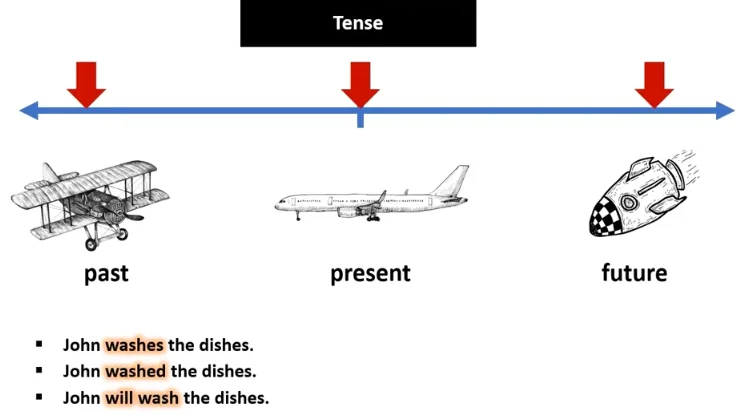
- John washes the plates and dishes
- He’s washing the plates and dishes.
John washed the plates and dishes.
In the aforementioned sentences, the verb is in the present tense. But, if the activity happened in the past we would write them as:
Now our verb is in the past tense. And if he, does it in the future.
John will wash the plates and dishes.
Aspects of Verbs
It’s important to note that it doesn’t have to be a long time ago or in the future. A second ago, a minute ago, five minutes ago, a century ago are all examples of the past, and the future will be the same. All times in the future are one minute in a year or a decade.
Next, we’ll talk about aspects, and I’ll leave the timeline up because aspects are a component of tension. The important thing to remember is whether the action is ongoing or concluded. Let’s start with a previously completed activity.
She flew the plane of her dad to the grandfather’s ranch.
Examples of Aspects
The basic aspect refers to an already accomplished task. As a result, this is a straightforward past tense example. But don’t forget that a simple present tense and a simple future tense would also be available. Another application of the simple past tense is for previous routine tasks. So, after school, she flew in her father’s plane. So that’s a finished activity, but it’s possible she did it more than once.
After that, we have a finished activity before moving on to the next one. So she had flown in her father’s plane before turning eleven. This is a wonderful illustration of an aspect. So, this is a verb in the past perfect tense. Take a look at this example of an ongoing action that was interrupted by another activity. When the lightning struck, she was piloting the plane. This is an illustration of the continuous feature. As a result, the verb is in the continuous past tense.
Then there was a continuous activity that came to an end before another action began. Before we arrived, she had been piloting the plane. This is an excellent example of a continuous aspect. As a result, the verb is in the perfect continuous tense in the past. Let’s just put them up now that we’ve finished with tense and aspect. There are four aspects and three tenses in all. Take another look at our verb to wash; there are twelve of them. As a result, a verb has 12 alternative forms.
Five Forms of Verbs
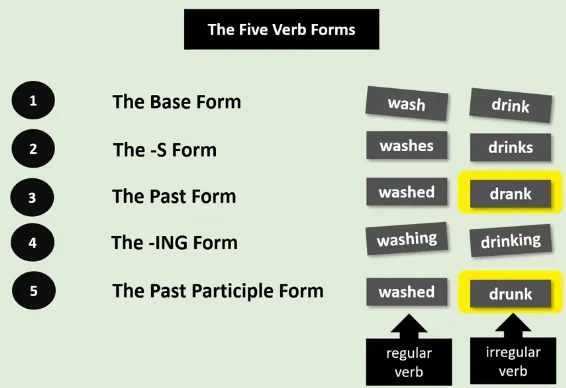
So, there’s the root form of the verb which is:
- =wash
- the s form=washes
- the past form=washed
- the ing form=washing
- the past participle form=washed
And you can make all twelve of the tenses. The infinitive form is also known as the basic form. It’s used after=will, but it’s also used after modal verbs as =can, may, should, and could, and it’s also the version you’ll find in the dictionary. This basic form has additional applications as well.
The Forms of verbs
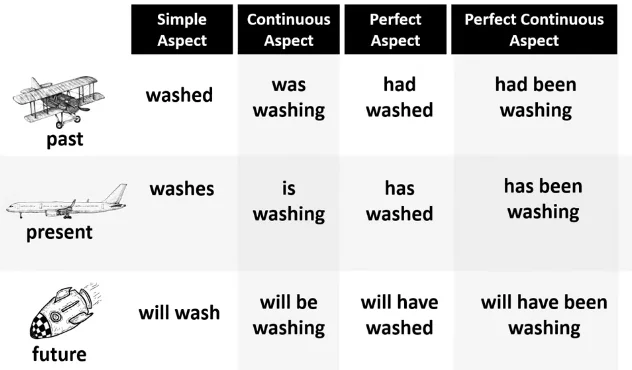
The s form: In this section, the s form is only used one time in the present tense.
The Past form: It is again just used onetime in the section of Past Tense.
- The ing form: used for six times in the continuous aspect and in the perfect continuous aspect.
- The past participle form: used in the perfect aspect you will have understood by now that the past participle form is as same as the past form of verb. But also used for regular verbs with irregular verbs like =to eat. The past form and past participle form of irregular verbs, for example, are distinct, and mastering the past form and past participle form of irregular verbs is a challenging portion of English.
- Voice is the last topic we’ll go through. So, let us return to John.
John washed the dishes.
Our verb’s =subject is John, who is performing the activity. As a result, this is a declarative phrase. But, this time, let’s turn our attention to the dishes, which were washed by John. The dishes are the topic of our sentence this time, but they are not doing the action. The action is directed towards the dishes, and the action is directed at the dishes. This is a passive statement.
Recap of Verbs
- Verbs represent physical, mental, or states of being; before you can pick a verb, you must first determine who or what is doing the activity. That is the topic.
- Then you must determine when the activity takes place. That’ll put you in the right frame of mind.
- The next step is to determine if the activity is ongoing or concluded, which will determine the aspect.
- It is necessary to evaluate whether your sentence is active or passive since this will influence the voice of your sentence and the structure of your phrase.
- Another is the mood of the verb, which only applies when we’re talking about inquiries or instructions.
- A verb is required in every phrase, and a verb indicates a physical or mental activity or a state of being.
